

30 Examples: How to Conclude a Presentation (Effective Closing Techniques)
By Status.net Editorial Team on March 4, 2024 — 9 minutes to read
Ending a presentation on a high note is a skill that can set you apart from the rest. It’s the final chance to leave an impact on your audience, ensuring they walk away with the key messages embedded in their minds. This moment is about driving your points home and making sure they resonate. Crafting a memorable closing isn’t just about summarizing key points, though that’s part of it, but also about providing value that sticks with your listeners long after they’ve left the room.
Crafting Your Core Message
To leave a lasting impression, your presentation’s conclusion should clearly reflect your core message. This is your chance to reinforce the takeaways and leave the audience thinking about your presentation long after it ends.
Identifying Key Points
Start by recognizing what you want your audience to remember. Think about the main ideas that shaped your talk. Make a list like this:
- The problem your presentation addresses.
- The evidence that supports your argument.
- The solution you propose or the action you want the audience to take.
These key points become the pillars of your core message.
Contextualizing the Presentation
Provide context by briefly relating back to the content of the whole presentation. For example:
- Reference a statistic you shared in the opening, and how it ties into the conclusion.
- Mention a case study that underlines the importance of your message.
Connecting these elements gives your message cohesion and makes your conclusion resonate with the framework of your presentation.
30 Example Phrases: How to Conclude a Presentation
- 1. “In summary, let’s revisit the key takeaways from today’s presentation.”
- 2. “Thank you for your attention. Let’s move forward together.”
- 3. “That brings us to the end. I’m open to any questions you may have.”
- 4. “I’ll leave you with this final thought to ponder as we conclude.”
- 5. “Let’s recap the main points before we wrap up.”
- 6. “I appreciate your engagement. Now, let’s turn these ideas into action.”
- 7. “We’ve covered a lot today. To conclude, remember these crucial points.”
- 8. “As we reach the end, I’d like to emphasize our call to action.”
- 9. “Before we close, let’s quickly review what we’ve learned.”
- 10. “Thank you for joining me on this journey. I look forward to our next steps.”
- 11. “In closing, I’d like to thank everyone for their participation.”
- 12. “Let’s conclude with a reminder of the impact we can make together.”
- 13. “To wrap up our session, here’s a brief summary of our discussion.”
- 14. “I’m grateful for the opportunity to present to you. Any final thoughts?”
- 15. “And that’s a wrap. I welcome any final questions or comments.”
- 16. “As we conclude, let’s remember the objectives we’ve set today.”
- 17. “Thank you for your time. Let’s apply these insights to achieve success.”
- 18. “In conclusion, your feedback is valuable, and I’m here to listen.”
- 19. “Before we part, let’s take a moment to reflect on our key messages.”
- 20. “I’ll end with an invitation for all of us to take the next step.”
- 21. “As we close, let’s commit to the goals we’ve outlined today.”
- 22. “Thank you for your attention. Let’s keep the conversation going.”
- 23. “In conclusion, let’s make a difference, starting now.”
- 24. “I’ll leave you with these final words to consider as we end our time together.”
- 25. “Before we conclude, remember that change starts with our actions today.”
- 26. “Thank you for the lively discussion. Let’s continue to build on these ideas.”
- 27. “As we wrap up, I encourage you to reach out with any further questions.”
- 28. “In closing, I’d like to express my gratitude for your valuable input.”
- 29. “Let’s conclude on a high note and take these learnings forward.”
- 30. “Thank you for your time today. Let’s end with a commitment to progress.”
Summarizing the Main Points
When you reach the end of your presentation, summarizing the main points helps your audience retain the important information you’ve shared. Crafting a memorable summary enables your listeners to walk away with a clear understanding of your message.
Effective Methods of Summarization
To effectively summarize your presentation, you need to distill complex information into concise, digestible pieces. Start by revisiting the overarching theme of your talk and then narrow down to the core messages. Use plain language and imagery to make the enduring ideas stick. Here are some examples of how to do this:
- Use analogies that relate to common experiences to recap complex concepts.
- Incorporate visuals or gestures that reinforce your main arguments.
The Rule of Three
The Rule of Three is a classic writing and communication principle. It means presenting ideas in a trio, which is a pattern that’s easy for people to understand and remember. For instance, you might say, “Our plan will save time, cut costs, and improve quality.” This structure has a pleasing rhythm and makes the content more memorable. Some examples include:
- “This software is fast, user-friendly, and secure.”
- Pointing out a product’s “durability, affordability, and eco-friendliness.”
Reiterating the Main Points
Finally, you want to circle back to the key takeaways of your presentation. Rephrase your main points without introducing new information. This reinforcement supports your audience’s memory and understanding of the material. You might summarize key takeaways like this:
- Mention the problem you addressed, the solution you propose, and the benefits of this solution.
- Highlighting the outcomes of adopting your strategy: higher efficiency, greater satisfaction, and increased revenue.
Creating a Strong Conclusion
The final moments of your presentation are your chance to leave your audience with a powerful lasting impression. A strong conclusion is more than just summarizing—it’s your opportunity to invoke thought, inspire action, and make your message memorable.
Incorporating a Call to Action
A call to action is your parting request to your audience. You want to inspire them to take a specific action or think differently as a result of what they’ve heard. To do this effectively:
- Be clear about what you’re asking.
- Explain why their action is needed.
- Make it as simple as possible for them to take the next steps.
Example Phrases:
- “Start making a difference today by…”
- “Join us in this effort by…”
- “Take the leap and commit to…”
Leaving a Lasting Impression
End your presentation with something memorable. This can be a powerful quote, an inspirational statement, or a compelling story that underscores your main points. The goal here is to resonate with your audience on an emotional level so that your message sticks with them long after they leave.
- “In the words of [Influential Person], ‘…'”
- “Imagine a world where…”
- “This is more than just [Topic]; it’s about…”
Enhancing Audience Engagement
To hold your audience’s attention and ensure they leave with a lasting impression of your presentation, fostering interaction is key.
Q&A Sessions
It’s important to integrate a Q&A session because it allows for direct communication between you and your audience. This interactive segment helps clarify any uncertainties and encourages active participation. Plan for this by designating a time slot towards the end of your presentation and invite questions that promote discussion.
- “I’d love to hear your thoughts; what questions do you have?”
- “Let’s dive into any questions you might have. Who would like to start?”
- “Feel free to ask any questions, whether they’re clarifications or deeper inquiries about the topic.”
Encouraging Audience Participation
Getting your audience involved can transform a good presentation into a great one. Use open-ended questions that provoke thought and allow audience members to reflect on how your content relates to them. Additionally, inviting volunteers to participate in a demonstration or share their experiences keeps everyone engaged and adds a personal touch to your talk.
- “Could someone give me an example of how you’ve encountered this in your work?”
- “I’d appreciate a volunteer to help demonstrate this concept. Who’s interested?”
- “How do you see this information impacting your daily tasks? Let’s discuss!”
Delivering a Persuasive Ending
At the end of your presentation, you have the power to leave a lasting impact on your audience. A persuasive ending can drive home your key message and encourage action.
Sales and Persuasion Tactics
When you’re concluding a presentation with the goal of selling a product or idea, employ carefully chosen sales and persuasion tactics. One method is to summarize the key benefits of your offering, reminding your audience why it’s important to act. For example, if you’ve just presented a new software tool, recap how it will save time and increase productivity. Another tactic is the ‘call to action’, which should be clear and direct, such as “Start your free trial today to experience the benefits first-hand!” Furthermore, using a touch of urgency, like “Offer expires soon!”, can nudge your audience to act promptly.
Final Impressions and Professionalism
Your closing statement is a chance to solidify your professional image and leave a positive impression. It’s important to display confidence and poise. Consider thanking your audience for their time and offering to answer any questions. Make sure to end on a high note by summarizing your message in a concise and memorable way. If your topic was on renewable energy, you might conclude by saying, “Let’s take a leap towards a greener future by adopting these solutions today.” This reinforces your main points and encourages your listeners to think or act differently when they leave.
Frequently Asked Questions
What are some creative strategies for ending a presentation memorably.
To end your presentation in a memorable way, consider incorporating a call to action that engages your audience to take the next step. Another strategy is to finish with a thought-provoking question or a surprising fact that resonates with your listeners.
Can you suggest some powerful quotes suitable for concluding a presentation?
Yes, using a quote can be very effective. For example, Maya Angelou’s “People will forget what you said, people will forget what you did, but people will never forget how you made them feel,” can reinforce the emotional impact of your presentation.
What is an effective way to write a conclusion that summarizes a presentation?
An effective conclusion should recap the main points succinctly, highlighting what you want your audience to remember. A good way to conclude is by restating your thesis and then briefly summarizing the supporting points you made.
As a student, how can I leave a strong impression with my presentation’s closing remarks?
To leave a strong impression, consider sharing a personal anecdote related to your topic that demonstrates passion and conviction. This helps humanize your content and makes the message more relatable to your audience.
How can I appropriately thank my audience at the close of my presentation?
A simple and sincere expression of gratitude is always appropriate. You might say, “Thank you for your attention and engagement today,” to convey appreciation while also acknowledging their participation.
What are some examples of a compelling closing sentence in a presentation?
A compelling closing sentence could be something like, “Together, let’s take the leap towards a greener future,” if you’re presenting on sustainability. This sentence is impactful, calls for united action, and leaves your audience with a clear message.
- 30 Examples of Teamwork Self Evaluation Comments
- Effective Nonverbal Communication in the Workplace (Examples)
- 30 Examples of Follow-Up Email Subject Lines
- 5 Effective Examples: How to Write a Two-Week Notice
- 2 Examples of an Effective and Warm Letter of Welcome
- 8 Examples of Effective Interview Confirmation Emails
10 Powerful Examples of How to End a Presentation
- By Illiya Vjestica
- - January 23, 2023
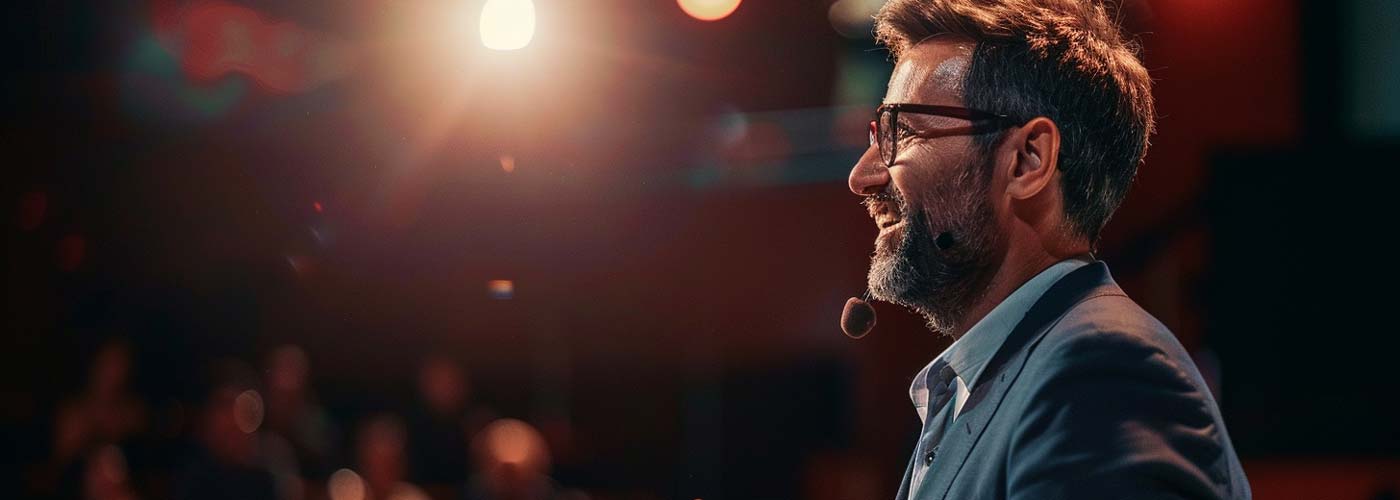
Here are 10 powerful examples of how to end a presentation that does not end with a thank you slide.
How many presentations have you seen that end with “Thank you for listening” or “Any questions?” I bet it’s a lot…
“Thank you for listening.” is the most common example. Unfortunately, when it comes to closing out your slides ending with “thank you” is the norm. We can create a better presentation ending by following these simple examples.
The two most essential slides of your deck are the ending and intro. An excellent presentation ending is critical to helping the audience to the next step or following a specific call to action.
There are many ways you can increase your presentation retention rate . The most critical steps are having a solid call to action at the end of your presentation and a powerful hook that draws your audience in.
What Action do You Want Your Audience to Take?
Before designing your presentation, start with this question – what message or action will you leave your audience with?
Are you looking to persuade, inspire, entertain or inform your audience? You can choose one or multiple words to describe the intent of your presentation.
Think about the action words that best describe your presentation ending – what do you want them to do? Inspire, book, learn, understand, engage, donate, buy, book or schedule. These are a few examples.
If the goal of your presentation is to inspire, why not end with a powerful and inspiring quote ? Let words of wisdom be the spark that ignites an action within your audience.
Here are three ways to end your presentation:
- Call to Action – getting the audience to take a specific action or next step, for example, booking a call, signing up for an event or donating to your cause.
- Persuade – persuading your audience to think differently, try something new, undertake a challenge or join your movement or community.
- Summarise – A summary of the key points and information you want the audience to remember. If you decide to summarise your talk at the end, keep it to no more than three main points.
10 Examples of How to End a Presentation
1. Asking your audience to take action or make a pledge.
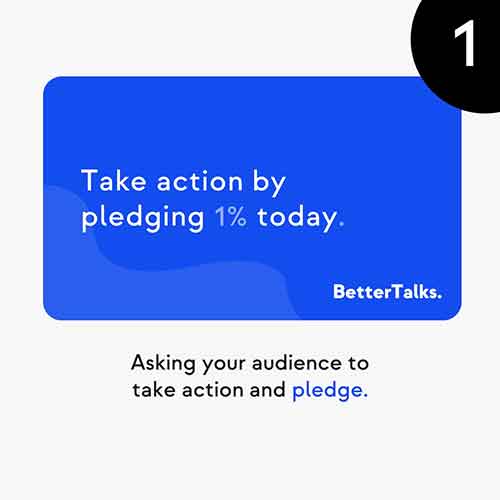
Here were asking the audience to take action by using the wording “take action” in our copy. This call to action is a pledge to donate. A clear message like this can be helpful for charities and non-profits looking to raise funding for their campaign or cause.
2. Encourage your audience to take a specific action, e.g. joining your cause or community
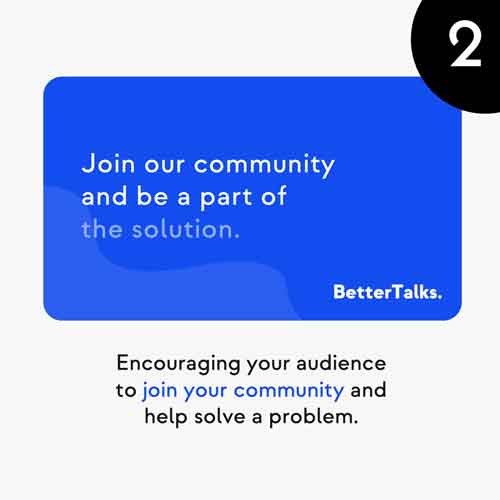
Here was are asking the audience to join our community and help solve a problem by becoming part of the solution. It’s a simple call to action. You can pass the touch to your audience and ask them to take the next lead.
3. Highlight the critical points for your audience to remember.
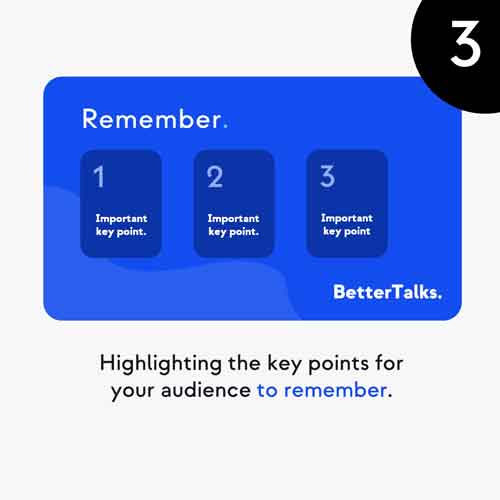
Rember, to summarise your presentation into no more than three key points. This is important because the human brain struggles to remember more than three pieces of information simultaneously. We call this the “Rule of Three”.
4. If you are trying to get more leads or sales end with a call to action to book a demo or schedule a call.
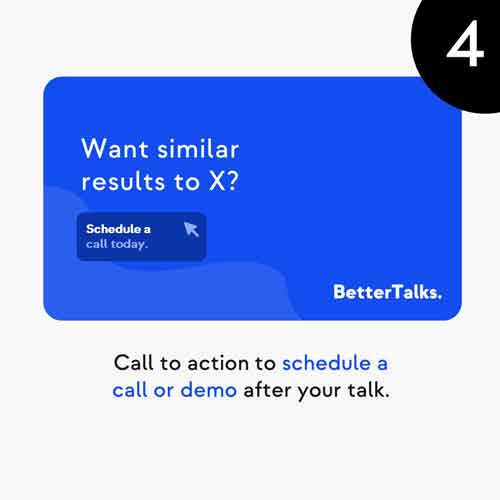
Can you inspire your audience to sign up for a demo or trial of your product? Structure your talk to lead your prospect through a journey of the results you generate for other clients. At the end of your deck, finish with a specific call to action, such as “Want similar results to X?”
Make sure you design a button, or graphic your prospect can click on when you send them the PDF version of the slides.
5. Challenge your audience to think differently or take action, e.g. what impact could they make?
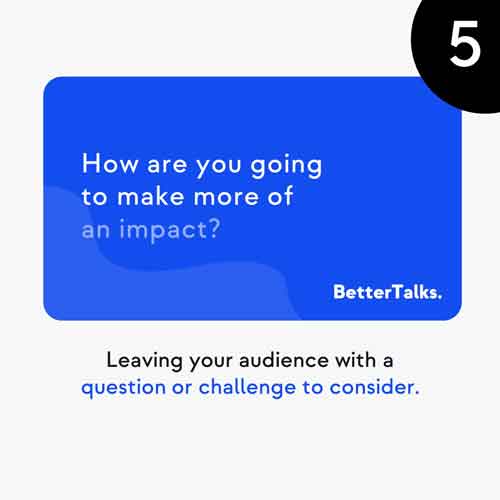
6. Give your audience actions to help share your message.
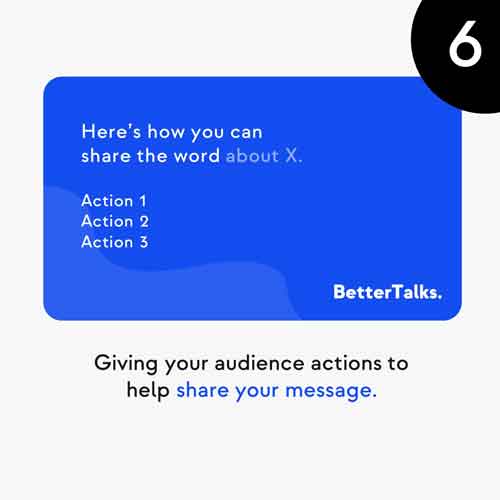
7. Promote your upcoming events or workshops
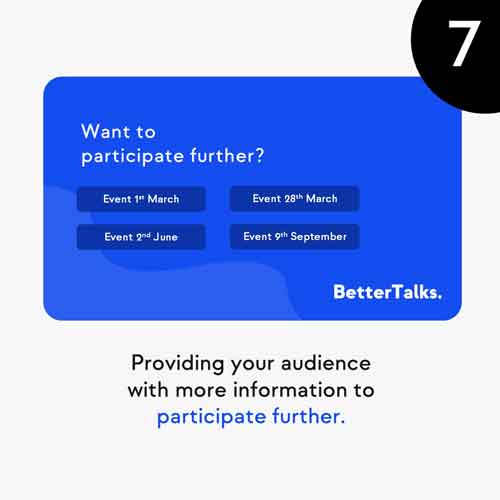
8. Asking your audience to become a volunteer.
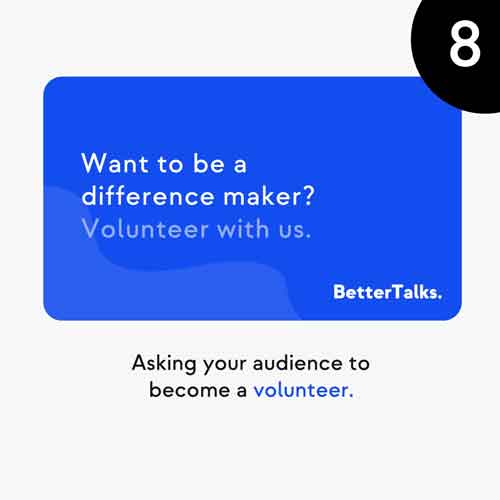
9. Direct your audience to learn more about your website.
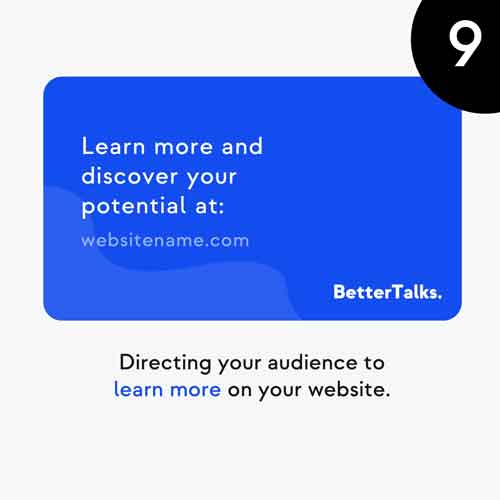
10. If you are a book author, encourage your audience to engage with your book.
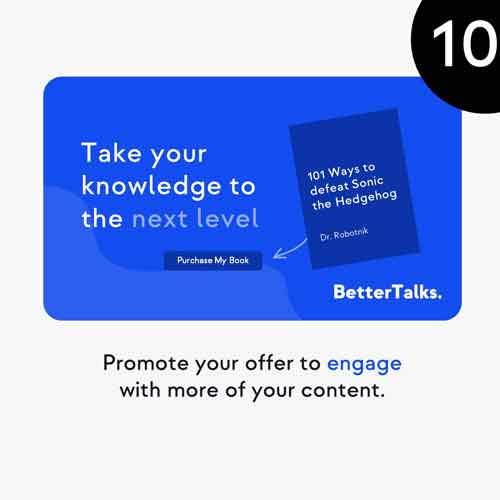
6 Questions to Generate an Ending for Your Presentation
You’ve told an engaging story, but why end your presentation without leaving your audience a clear message or call to action?
Here are six great questions you can ask yourself to generate an ending for your presentation or keynote talk.
- What impression would you want to leave your audience with?
- What is the big idea you want to leave them with?
- What action should they take next?
- What key point should you remember 72 hours after your presentation?
- What do you want them to feel?
- What is the key takeaway for them to understand?
What to Say After Ending a Presentation?
When you get to the end of a book, you don’t see the author say, “thank you for reading my last chapter.” Of course, there is no harm in thanking the audience after your presentation ends, but don’t make that the last words you speak.
Think of the ending of the presentation as the final chapter of an epic novel. It’s your chance to leave a lasting impression on the audience. Close with an impactful ending and leave them feeling empowered, invigorated and engaged.
- Leave a lasting impression.
- Think of it as the last chapter of a book.
- Conclude with a thought or question.
- Leave the audience with a specific action or next step.
How to End a Presentation with Style?
There are many great ways you can end your presentation with style. Are you ready to drop the mic?
Ensure your closing slide is punchy, has a clear headline, or uses a thought-provoking image.
You want to capture the audience’s attention before closing the presentation. Make sure the fonts you choose and are clear and easy to read. And What are the Best Colours for Your PowerPoint presentation? Use them wisely.
Do you need to consider adding a link? If you add links to your social media accounts, use icons and buttons to make them easy to see. Add a link to each button or icon. By doing this, if you send the PDF slides to people, they can follow the links to your various accounts.
What Should you Remember?
💡 If you take one thing away from this post, it’s to lose the traditional ending slides. Let’s move on from the “Thank you for your attention.” or “Any questions.” slides.
These don’t help you or the audience. Respect them and think about what they should do next. You may be interested to learn 3 Tactics to Free Your Presentation Style to help you connect to your audience.
Create stunning presentations with our templates, toolkits and guides.
Illiya Vjestica
Share this post:, related posts.
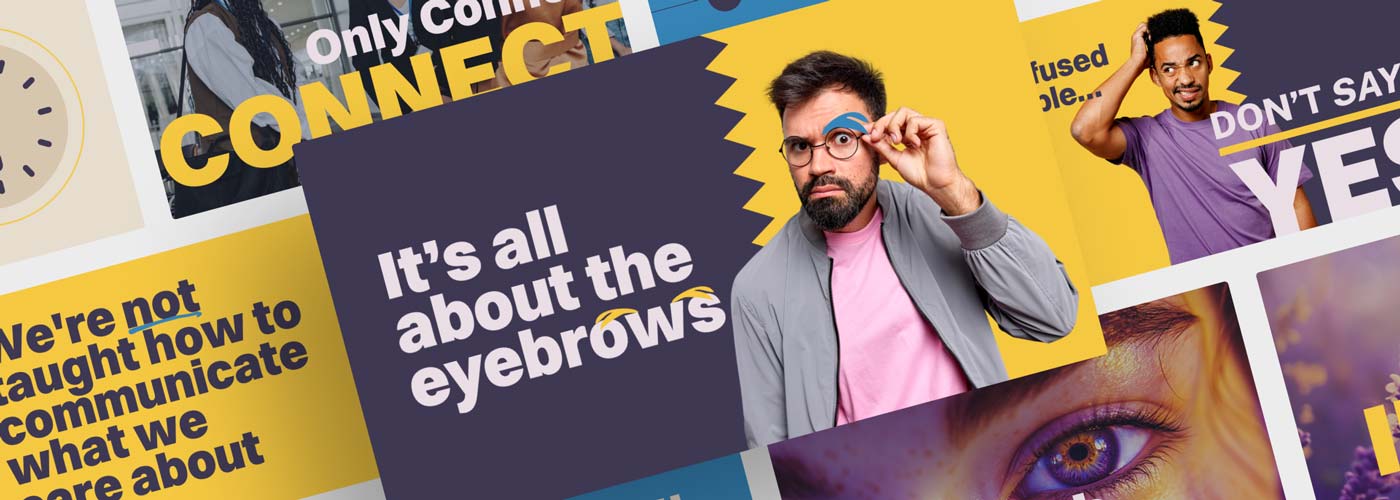
Make Your Slides Intriguing Like Author Sam Horn

7 Surprising Benefits of Using Google Slides
Leave a comment cancel reply.
Your email address will not be published. Required fields are marked *
We use cookies to enhance your experience. By continuing to visit this site, you agree to our use of cookies

- Video Marketing
- Case Studies
- Create a video
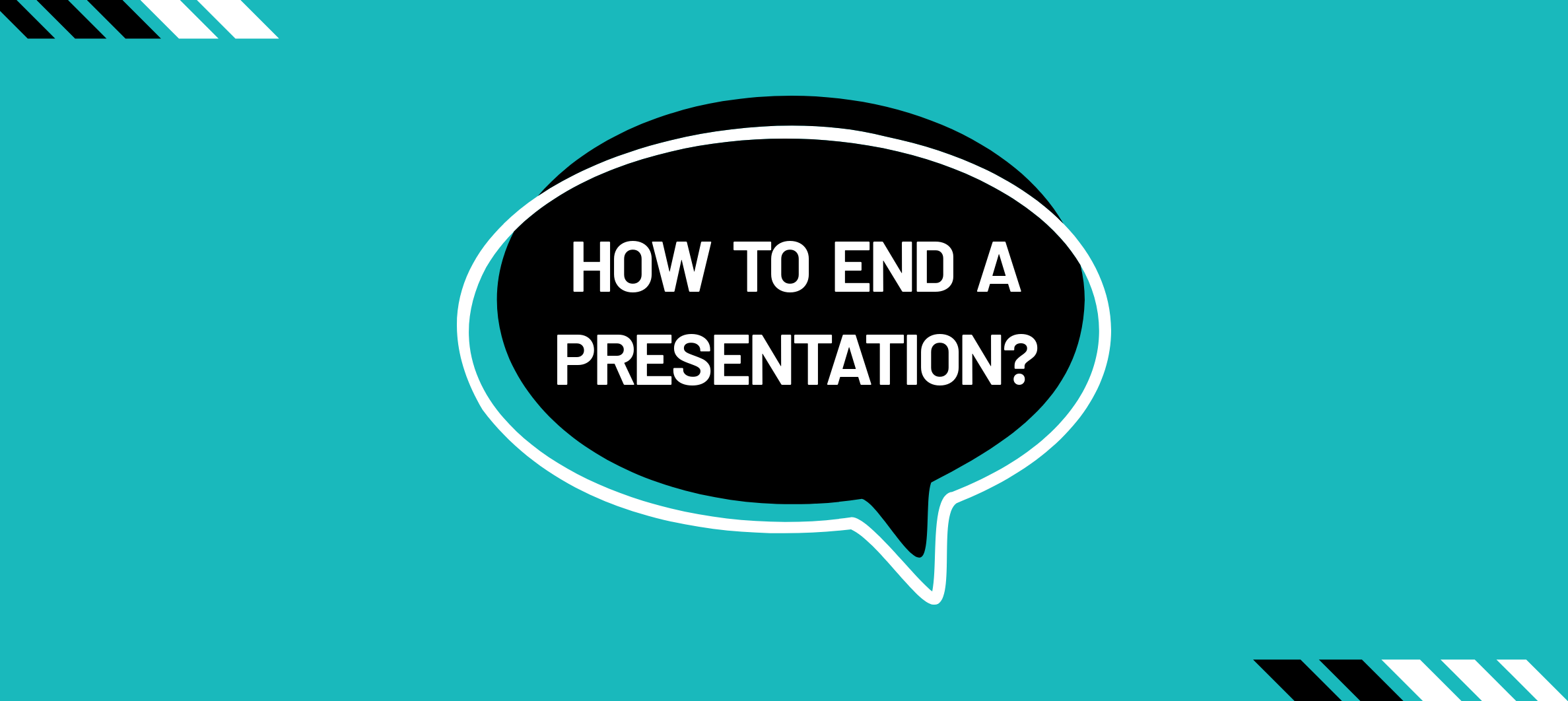
How to End a Presentation? [Top 8 Strategies with Examples]
Guru - May 9, 2023 - Leave your thoughts. 9 min read
animaker deck , presentation , presentation ideas , Presentation Software , presentation tips
How you end a presentation is just as crucial as its opening. It can make or break the impression that you leave on your audience.
A strong conclusion can reinforce your key message and ensure that your audience remembers it even after the presentation is over.
A well-concluded presentation can leave your audience impressed, energized, and motivated to take action.
So now, are you wondering what’s the best way to conclude your presentation? Don’t worry! You have come to the right place!
To help you make a powerful ending to your presentation, we have compiled a list of 8 different strategies in this blog post.
Each of these strategies is designed to help you create a memorable and impactful conclusion to your presentation.
By choosing the most appropriate one for your presentation, you can ensure that your audience remembers your key message and feels motivated to take action.
Let’s jump right in,
1. Emphasize the core message 2. Mirror your opening statement 3. Pose an open-ended question 4. End with a Call to action 5. Thank the audience 6. End with a powerful quote 7. Acknowledge your contributors 8. Ask for feedback
1. Emphasize the core message:
One of the most important aspects of any presentation is ensuring your audience understands your core message.
Reiterating your main points and summarizing your message at the end of your presentation can reinforce this and leave a lasting impression.
It helps to ensure that your audience understands the purpose of your presentation and has a clear takeaway from the information you have provided.
In this video, the speaker restates her topic to conclude her speech firmly and gives a pause, resulting in tremendous applause from the audience.
Similarly, by restating your core message, you can also create a sense of cohesion and give your presentation a firm closure.
This can be particularly important if you want to motivate your audience to take action or influence their behavior in some way.
However, it's important not to repeat EVERYTHING you have said. Instead, focus on the most crucial elements and highlight them in a concise and clear manner.
2. Mirror your opening statement:
A great way to end your presentation is by mirroring your opening statement in your conclusion.
Highlighting your presentation's key message at the end and emphasizing the central idea you aimed to communicate will help your audience to retain it in their memory.
During the conclusion of the presentation, the speaker effectively utilized the technique of mirroring the opening example she had presented - ordering a pizza on the phone by herself.
The speaker demonstrated the remarkable transformation she had undergone in terms of personal growth and confidence, which strongly reinforced her message to the audience.
By mirroring her opening example, she created a sense of familiarity and connection with her audience while simultaneously driving home the key message of her presentation.
This technique allowed the audience to understand better and relate to the speaker's personal journey and the message she was conveying.
Similarly, you can also use this strategy to conclude your presentation. This can be particularly effective if you are trying to reinforce a specific theme or idea throughout your presentation.
3. Pose an open-ended question:
One of the best ways to conclude your presentation is to elicit a response from your audience using an open-ended question that can effectively engage them and make your presentation more memorable.
Look at how the speaker concludes her speech with an open-ended question in this video.
Similarly, you can also raise open-ended questions to help your audience look from a different perspective and encourage them to investigate more thoroughly on the information presented.
Most importantly, ensuring that your question is relevant to your presentation and doesn't detract from your overall message is essential when eliciting a response.
So make sure that you kindle your audiences’ thoughts and ideas with the open-ended question at the end. This helps create a good long-lasting impression of your presentation.
4. End with a Call to action:
One of the best ways to end your presentation is by concluding with a call to action slide.
Incorporating a call to action into your presentation can be a powerful way to encourage your audience to take the next step.
Whether it's signing up for a program, making a purchase, or supporting a cause, a clear call to action is essential to achieving your desired outcome.
Similarly, according to your type of presentation, you can include a relevant call to action.
For example, this might involve providing specific instructions or offering an incentive for taking action, such as a discount or free trial.
It's essential that you understand their pain points and make your call to action compelling. Ensure that your core message and the needs of your audience are aligned so that they are motivated enough to act.
5. Thank the audience:
At the end of your presentation, it's essential to recognize that your audience has taken time out of their busy schedules to attend and listen to your message.
Thanking your audience for their time and attention can create a positive impression and make them feel appreciated.
It's essential to make your gratitude genuine and sincere rather than a superficial gesture. For example, consider expressing your gratitude with a personal anecdote or acknowledging specific individuals in the audience.
This simple act of gratitude can also create a sense of personal connection and signal to your audience that the presentation has reached its conclusion, paving the way for future interactions with them.
6. End with a powerful quote:
One effective strategy to end your presentation on a high note is by leaving the audience with a powerful quote.
However, it's crucial to choose a quote that is not only impactful but also unique and relevant to your topic.
Using a commonly known quote may come across as unoriginal and irrelevant, losing the attention and interest of your audience in most cases.
In this presentation, Steve Jobs concludes his speech with an inspiring and powerful message, “Stay Hungry! Stay Foolish”. Thereby emphasizing that you should never stop learning, pursue more goals, and never stop being satisfied.
Similarly, in your conclusion, consider using a relevant quote to make an impact.
7. Acknowledge your contributors:
Another best way to conclude your presentation is by showing gratitude to your contributors.
For example, if you deliver a business presentation on behalf of a team or a department, it's essential to recognize the collective effort that went into creating the presentation.
The concluding moments of your speech are the perfect opportunity to acknowledge your team members' hard work and dedication.
You can express gratitude to your team as a whole, thanking them for their contribution to the presentation.
However, if you want to ensure that the individual efforts of team members are recognized, highlighting specific contributions may be a better approach.
Some examples include:
"Join me in giving a round of applause to my incredible team, who played a significant role in arranging this pitch deck."
"Finally, I would like to mention that my tech team experts provided me with insight into the technical nuances, and without their contribution, this presentation would not have been as informative as it is now."
"As I conclude, I want to express my gratitude to Mark and Serene from the Marketing team, whose assistance in gathering the data and designing the slides was invaluable."
By acknowledging individual team members, you are demonstrating your appreciation for their work and giving them the recognition they deserve.
This will not only make them feel valued but also motivate them to continue contributing to the success of future presentations.
So be sure to end your presentation with the required acknowledgment for all the contributions.
8. Ask for feedback:
You can conclude your presentation seamlessly by thanking the audience and asking for feedback from them.
Encouraging feedback from your audience can greatly benefit your future presentations. It allows you to understand how your message was received and how you can improve for the next time.
So, how can you gather feedback effectively?
Firstly, ask attendees to share their thoughts on your presentation after you finish speaking. This can be done by initiating a Q&A session or by approaching individuals directly.
Another option is to set up a QR code near the exit and ask people to scan and jot down their thoughts on the online form as they leave. This allows attendees to provide their feedback in a confidential and hassle-free manner.
Also, consider having a suggestion box for handwritten feedback notes or creating an anonymous online survey that links to your presentation slides. This method is beneficial if you want to gather feedback from a large audience or if you prefer to have quantitative data.
By actively seeking feedback, you show your audience that you value their input and are committed to improving your presentation skills.
However, this strategy does not apply to all the general presentations. So use this way of concluding your presentation where it makes more sense to you and the audience.
In summary, an impactful conclusion is vital to wrap up your presentation successfully.
Each of these strategies serves a unique purpose, and by combining them, you can create a conclusion that is both engaging and impactful.
By incorporating the 8 critical strategies mentioned in this guide, you can leave a lasting impression on your audience, ensuring that your message stays with them even after the presentation has ended.
Now that you have learned the pro strategies of how to end a presentation, take a look at this guide on “How to start a presentation” as well and nail your presentation from start to end!
If you are still uncertain about how to make a presentation from the ground up, we suggest checking out Animaker Deck - the world's first avatar-driven presentation software.
With over 40 distinct and creatively designed templates at your disposal, we are confident you will find it worth trying!
We hope this article was helpful. Do let us know your thoughts on which strategy worked best for you, and also suggest your own ways of ending a presentation.
Related Posts
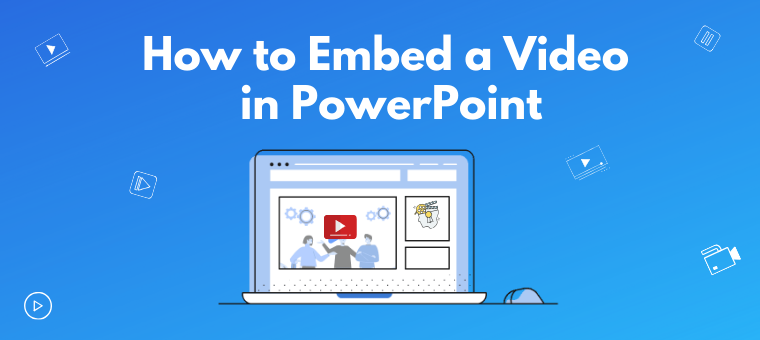
How to Embed a Video in Powerpoint? [Supercharge your PPTs Now]
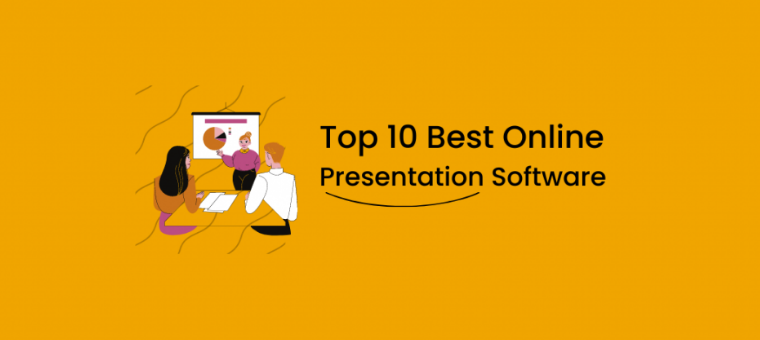
Top 10 Presentation Software for 2023

25 Best Presentation Templates for the Perfect Pitch [For 2023]
Subscribe to get awesome DIY tips that could break the boundaries of other DIY tools.
Create Engaging Animated Videos On Your Own
Our drag-and-drop builder makes it easy for anyone to create pro-level animated videos using pre-made templates and ready-to-go assets with zero technical skills.
5 Effective and powerful ways to end a presentation!
Learn about their importance, common mistakes, and examples to conclude your presentation successfully!
Supriya Sarkar
Delivering presentations

Table of contents
Presentations are not just about delivering information; they are about leaving a lasting impact on your audience. The conclusion holds immense significance as it's the final chance to reinforce key messages, prompt action, and make a memorable impression. Research indicates a 25% reduction in our attention spans , highlighting the need for powerful conclusions to enhance retention.
In this guide, we'll look into the importance of ending a presentation effectively. Also, we will explore five effective techniques for concluding presentations with examples to end and common mistakes to avoid during this critical phase.
Why are presentation conclusions important?
When we engage in a movie or a lengthy session, our memory often captures the beginning, end, and occasionally some highlights from the middle. This tendency arises from the brain's limited capacity for sustained attention.
Nobel Prize-winning psychologist Daniel Kahneman explained the profound concept that explains the difference between the experiencing self and the remembering self . According to Kahneman, the experiencing self perceives events in the present moment, while the remembering self reflects on them afterward. Importantly, he emphasizes that our recollection of events is significantly shaped by their endings.
In presentations, where specific objectives are central, the conclusion becomes important. If the end of your presentation fails to impress or facilitate retention, its purpose is compromised. Therefore, the conclusion of a presentation serves several critical purposes:
- Reinforcing key messages: Summarizing the main points of your presentation reinforces them in the minds of your audience. Repetition aids retention, ensuring that your key messages are remembered long after the presentation ends.
- Motivating action: A well-crafted conclusion includes a clear call to action (CTA) that prompts the audience to take specific steps. Whether it's signing up for a service, implementing a strategy, or simply reflecting on the presented information, a compelling CTA bridges the gap between knowledge and action.
- Leaving an impression: The conclusion is your final opportunity to leave a memorable impression on your audience. It is the part of the presentation that lingers in their minds, shaping their perception of your message and your credibility as a speaker.

How to conclude a presentation? 5 Effective techniques:
When concluding a presentation, employing certain techniques can significantly strengthen your closing, thereby enhancing retention and impact levels. Let's explore five effective strategies to achieve this goal.
Summarization:
Summarizing the key points of your presentation reinforces them in the minds of your audience. Keep the summary concise, focusing on the most important takeaways. This technique ensures that your main messages stick with the audience long after the presentation is over.
Example of a short and crip summary: “In summary, our Q3 revenue surged by 20%, largely propelled by strong sales in the Asian market. However, to boost profitability, we must prioritize cost reduction efforts moving forward."
Emphasize a CTA:
A call to action is a powerful way to motivate your audience to take specific steps based on the information you've presented. Whether it's signing up for a service, making a purchase, or implementing a new strategy, a clear and compelling CTA guides your audience toward specific actions.
Example of a conclusion that motivates to take an action: "As we wrap up, I encourage all stakeholders to join us in this exciting journey. Let's collaborate to implement these strategies to cut carbon emissions by 42% by 2030. Together, we can drive meaningful change and propel our organization to new heights."
Audience engagement:
Engaging your audience in the conclusion helps maintain their attention and involvement until the end. This could involve asking thought-provoking questions, inviting feedback, or sharing relevant anecdotes that resonate with your audience.
Example of a feedback invitation before the conclusion: "Before we conclude, I would like to invite you to share one key takeaway from today's presentation. Let's take a moment to reflect on how we can apply these insights in our roles. Who would like to start?"
You can learn more about engaging your audience during a presentation in our detailed conversation with industry leaders and experts in this podcast.
Persuasion technique:
Employ persuasive language and storytelling techniques to drive home your message in the conclusion. You can make smart use of anecdotes, statistics, or testimonials to add credibility and emotional appeal to your presentation.
An impressive example of persuasion:
"In conclusion, I want to leave you with a powerful statistic: studies show that companies that prioritize employee well-being experience a 22% increase in productivity. By investing in initiatives that support our team's health and happiness, we're not just improving morale—we're driving tangible business results. Let's make employee well-being a top priority moving forward."
To learn more about advanced persuasion techniques you can explore our extensive guide here which dives into the topic in detail and provides examples for better understanding.
Conceptualization:
Conclude your presentation by effectively describing the future state or desired outcome. Help your audience visualize the benefits of implementing your ideas or solutions, inspiring them to action.
An example of a conclusion where conceptualization is used:
"In conclusion , let's envision the future with AI as our innovative solution. Imagine a scenario where AI streamlines our processes, enhances our decision-making, and drives unprecedented growth. By embracing AI technology, we empower our team to achieve remarkable results and stay ahead of the curve in our industry. Together, let's harness the power of AI to shape a brighter tomorrow."
What mistakes do you need to avoid at the end of a presentation?
Presenters sometimes make mistakes when wrapping up their presentations, which can weaken the impact they've built. By recognizing and avoiding these mistakes, you can ensure your presentation ends on a high note and leaves a lasting impression. Let's explore some common errors and how to steer clear of them to a strong conclusion.
Rushing to end a presentation:
One of the biggest mistakes presenters make is abruptly ending the presentation without a proper conclusion. This can throw off audience interest and leave them feeling disoriented.
Solution: Allocate sufficient time for the closing remarks to ensure a smooth and impactful conclusion. A well-paced conclusion allows for a seamless transition between points, keeping the audience engaged and focused on your message.
Overloading your conclusion:
Many presenters make the mistake of overloading the final slide with too much information, overwhelming the audience and detracting from the main message. Also, introducing new information at this stage can detract from the presentation's purpose.
Solution : To avoid this, focus on summarizing the key points concisely. Aim for a clear and concise conclusion that reinforces the main message without introducing new information. This ensures that your audience retains the information presented without feeling overwhelmed.
Avoid ending your presentation with Q&A:
While the Q&A session is valuable, using it as the conclusion can lead to an abrupt ending without proper closure for the audience.
Solution: Instead, provide the audience with a closing statement or a strong takeaway from your presentation. This helps you to provide clarity and direction, enhancing understanding and retention of the information presented.
Unaligned conclusions:
The conclusion should align with the presentation introduction to ensure a cohesive narrative. An unaligned conclusion makes the audience feel disoriented and impacts their ability to retain information.
Solution: To address this, create a sense of cohesion by referencing elements introduced at the beginning of your presentation. This could be a story, quote, or theme that ties your introduction to your conclusion. End your presentation with a memorable statement or compelling call to action to leave a lasting impression on your audience.
Inability to adapt the presentation end:
Not paying attention to audience reactions can lead to a lackluster conclusion. It's essential to read audience cues and adapt the end of the presentation accordingly.
Solution: Adjust your tone, pace, and content based on the audience's nonverbal cues to maintain engagement. Ensure that you remain flexible and prepared to adjust your conclusion based on audience reactions. This will also ensure continued receptiveness from the audience. Flexibility is key to addressing unforeseen circumstances while maintaining the integrity of your message.
Did you know that 80% of human communication is conveyed through body language and other non-verbal cues? That's why mastering the art of reading your audience is essential if you want to make a lasting impression. Read our detailed article to learn more about effectively interpreting your audience's non-verbal cues and optimizing your communication skills.
Skipping the Call to Action (CTA):
If you skip suggesting any prompt action from the audience, it can result in unappealing endings to presentations. On the other hand, if your presentation includes a call to action or concludes with a compelling statement, that motivates your audience to take the desired steps.
Solution: Clearly state what you want your audience to do next, whether it's signing up, implementing a strategy, or reflecting on the presented information. Communicate what you want them to do next and why it's important. A strong call to action will help you reinforce the message and at the same time encourage your audience to act upon it, bridging the gap between information and implementation.
Overusing clichés as a way to end:
While expressing gratitude is important, relying on generic phrases like “Thank you for your time” is not a strong way to end your presentation. These clichés have been overused and trigger a default response from the audience, resulting in immediate disengagement.
Solution: Craft a unique and memorable closing that aligns with your message and leaves a strong impression on your audience. Express gratitude for their time and attention in a way that provides closure. For example, summarize the journey you've taken together throughout the presentation or conclude with a thought-provoking statement that leaves them with something to consider beyond the presentation.

Examples of how to end a presentation with conclusion slides:
Here are some examples of effective presentation conclusion slides that you can refer to for inspiration in crafting your next presentation's ending. Feel free to use them directly or adapt them to suit your specific needs and style. Downloading these templates can also help streamline your presentation creation process and save valuable time.

Key takeaways on presentation conclusion:
• End of presentations are crucial for leaving a lasting impact and ensuring audience retention. • Techniques like summarization, emphasizing a call to action, engaging the audience, employing persuasive language, and conceptualization can strengthen your core message. • Common mistakes to avoid in your powerpoint presentation include rushing to the end of your presentation, overloading it with information, ending with a Q&A, unaligned conclusions, and inability to adapt.
How can Prezent help to end your presentation with style?
Presentation software like Prezent can help you to conclude your business presentations effectively by providing a range of tools and features designed to enhance the closing stages of your presentations:
Templates: Prezent offers a variety of professionally designed slide templates that you can choose from. These templates include pre-designed conclusion slides covering various business scenarios with visually appealing layouts, making it easy for presenters to create impactful endings.
Auto-generate presentations: You can choose to generate an entirely new on-brand presentation if you don’t want to build one from scratch. This feature helps you quickly create presentations with impactful endings, which you can then refine and modify as per your requirements.
Training and resources : Prezent provides training materials and resources on effective presentation techniques , including tips for crafting compelling conclusions. You can access guides and industry best practices to improve your presentation skills and create more impactful endings.
Discover the full potential of Prezent's features and capabilities with our free trial today. If you prefer personalized guidance into our AI product, schedule a demo with our experts. We'll walk you through our platform, offering insights to streamline your business communications and presentation creation process effectively.
More zenpedia articles

Employee training and development presentation guide

Clinical trial investment decision: A presentation guide

How to start a resentation: 8 Powerful Approaches
Get the latest from Prezent community
Join thousands of subscribers who receive our best practices on communication, storytelling, presentation design, and more. New tips weekly. (No spam, we promise!)
- Microsoft Teams
- Cisco Webex
- Rocket.Chat
- Accessability
- Release Notes
- Public Roadmap
- Brainstorming
- Mindmapping
- Decision Making & Strategy
- Public Sector
- Coaching / Training
- Open Telekom Cloud
- Azure Switzerland
- On-Premises
- Confidential Cloud
- Online Help

End of presentation: 7 examples for the perfect conclusion
Ending a presentation is like adding the last stroke of a painter's brush - it rounds off the overall picture and creates a lasting impression. But how do you create a powerful end to a presentation that the audience will remember? Let's discover the secret together in this article.
What do you say at the end of a presentation?
You have given a convincing presentation, addressed everything important and got your message across effectively. Now you are faced with the challenge of finding a successful conclusion. This is where the right words matter. A simple "That's it" or "Thank you for your attention" will probably not be remembered by your audience. Instead, you can use a summary of your main points, a call-to-action or a catchy conclusion to leave a strong impression.
Why the end of your presentation is so important?
The end of a presentation is your last chance to leave a lasting impression. It gives you the opportunity to reinforce your message and inspire your audience, or spur them into action. It's not just about wrapping up your presentation, it's about ending it with a bang. Use this opportunity to reiterate your core message and make a strong emotional connection with your audience.
The principle of the recency effect
The recency effect states that people remember best what they heard last. This underlines why the end of your presentation is so important. If you design the end of your presentation effectively, your audience is more likely to remember it. Use this psychological phenomenon to your advantage and ensure that your conclusions and calls to action are remembered.
Presentation end: 7 examples to leave a lasting impression
- Summarize the main points: Repeat the main points of your presentation to reinforce them.
- Call-to-action: Ask your audience to perform a specific action or take a next step.
- Quote: A relevant and powerful quote can leave a lasting impression.
- Story or anecdote: A short, relevant story or anecdote can create an emotional connection and stick in the audience's mind.
- Questions: Ask a rhetorical or open-ended question that is thought-provoking.
- Surprising statistic or fact: An impressive statistic or fact can make a strong impression.
- Humorous remark: A funny remark or joke can lighten the mood and ensure a positive ending.
How to formulate a strong presentation ending
Formulating a strong presentation ending requires practice and creativity. Try to convey your core message in a way that suits your audience and your topic. Remember that your goal is to leave a lasting impression. Be clear, concise and engaging. Use metaphors or stories to illustrate your points and use rhetorical devices such as repetition and triples to reinforce your message. Here are some examples of how you can conclude your presentation:
- Summary and outlook: "Today we discussed the challenges and solutions for our product development. By implementing these solutions, our company will be even more innovative and efficient in the future."
- Call to action: "Now you know the advantages of our product. Let's exploit the opportunities that arise from this together. Let's start implementing it today!"
- Interaction question: "What do you think of these suggestions? Which measures do you see as a priority to achieve our goals?"
- Inspirational quote: "As Albert Einstein said: 'Life is like riding a bicycle. To keep your balance, you have to keep moving'. So let's keep moving and pursue our goals together."
- Positive outlook: "I am confident that with these strategies we can achieve our goals and continue our success."
Each of these closing formulations has its strengths. Choose the one that best suits your style, your audience and your topic. Find out here how you can structure your presentation to create the perfect ending.

Presentation end - Rhetorical questions as a tool
The dos and don'ts for a successful end to a presentation.
It is crucial to design this finale in such a way that it is effective and memorable. To help you do this, here's a clear list of dos and don'ts to keep in mind at the end of your presentation. These tips will give you guidance to captivate your audience until the curtain falls.
How long should the end of a presentation last?
Make the end of the presentation fun.
Humor can be a great way to end your presentation in a light and enjoyable way. A joke or funny anecdote can lighten the mood and make your audience laugh. However, make sure the humor is appropriate and relevant to your topic.
What comes at the end of the presentation?
The closing slide of your presentation is your last chance to make a lasting impression. It should summarize your main points and include a call-to-action. You can also include your contact details or links to further resources. Make the closing slide engaging and easy to read to reinforce your message.
Take your presentations to the next level with Collaboard
End of presentation: the art of making a lasting impression.
The end of your presentation is more than just a conclusion. It's your chance to leave a lasting impression, reinforce your message and inspire your audience to take action. Take advantage of this opportunity and use techniques such as repeating your main points, asking rhetorical questions or adding humor to end your presentation effectively. Remember the principle of the recency effect and design your presentation to be memorable. No matter which method you choose, be authentic and stay true to yourself. Your audience will thank you for it.
Checklist: Effective end of presentation
This checklist will help you evaluate the effectiveness of your presentation ending and make sure you've covered all the important aspects. From the clarity of your message to the emotional resonance, these points are crucial to captivating your audience and leaving a lasting impression.
- Clarity of message: Has the main message of your presentation been clearly communicated?
- Answering audience questions: Were relevant questions from the audience addressed during or at the end of your presentation
- Visual impact: Was a strong, powerful image or graphic used effectively to reinforce the message?
- Audience engagement: Were techniques such as direct questions, interactive elements or calls to action used to actively engage the audience?
- Emotional resonance: Did the end of your presentation evoke an emotional response, be it inspiration, thoughtfulness or joy?
- Summary of content: Were the main points of your presentation summarized clearly and concisely?
- Lasting impression: Does the end of your presentation leave a strong, lasting image in the minds of your audience?
- Learn here more about how to design a professional presentation
Case study: Impressive presentation endings
There are presentations that continue to occupy and inspire us long after they have finished. It's often the ending that leaves a lasting impression. To understand how to design a professional presentation ending, let's take a look at two case studies.
Steve Jobs at Apple product launches
Jobs' famous "One More Thing..." technique was a masterstroke in the art of presentation. After introducing a series of products or features during the presentation, it seemed as if he had reached the end. But then came the moment everyone was waiting for: Jobs returned to the stage, often with the words "There's one more thing...". These words caused great anticipation and excitement in the audience. This approach was more than just a clever finish. It became a trademark of Apple events and a synonym for innovation and surprise. The "One More Thing..." moments were often the introduction of groundbreaking products or features that would shape the technology world. This technique not only enhanced the impact of the presentation, but also left a sense of awe and curiosity.
The power of storytelling in TED Talks
TED Talks have established themselves worldwide as a platform for some of the most inspiring and influential presentations. A key element that sets TED presentations apart is the way speakers end their talks - often with a personal story or transformative experience. These stories are not only poignant, but also a powerful tool to reinforce the message of the presentation.
Presentation end - Frequently asked questions & answers
How do you end a presentation appropriately.
A good ending to a presentation includes a summary of the main points, a convincing conclusion, words of thanks and a willingness to answer questions.
What phrases are suitable for closing a presentation?
Possible phrases could be: "To conclude...", "To summarize...", "In conclusion, I would like to say...", "This brings me to the end of my presentation...".
Should you ask questions at the end of the presentation?
Yes, it is common and recommended to open a Q&A session at the end of the presentation to clear up any ambiguities and encourage dialog.
How should you respond to questions that you cannot answer?
It is important to be honest and admit if you cannot answer a question. You can offer to provide the answer later or ask the audience if someone else can answer the question.
What should you do if no questions are asked?
If no questions are asked, you can ask some prepared questions to stimulate discussion or highlight other aspects of the topic.
How do you thank the audience at the end of a presentation?
A simple "Thank you for your attention" or "Thank you for taking the time to listen to my presentation" is an appropriate way to say thank you.
Recent Posts from Blog
Two truths and a lie - the art of deception.
A playful mystery, a hint of suspense and the challenge of distinguishing the truth from the lie - all this is behind the...
5 Finger Feedback | Free Template
As a team leader, it is important that your team works together effectively and supports each other. One way to encourage this is...
Idea Management Software | Free Tool
Companies that focus on continuous improvement and innovation use idea management to make the most of their teams' creative...
Start-Stop-Continue | Tips + Templates
The core of the Start-Stop-Continue method is the constant reflection of one's own actions. If repeated consistently, it should...
Stay up to date with the latest collaboration tips and news.
- Interactive Presentation
How to End A Presentation in 2024 | Tips and Examples
Astrid Tran • 08 April, 2024 • 8 min read
How to end a presentation successfully ? First impression matters all the time, and the ending is no exception. Many presentations make mistakes in putting a lot of effort into designing a great opening but forget the closing.
With that in mind, the article aims to equip you with useful ways to have a complete presentation, especially on having an impressive and engaging ending. So let's dive in!
Learn to create better presentation
- Bad presentation at work
- How to Overcome Stage Fright
- Measure your presentation better with rating scale or Likert scale
Table of Contents
- The Importance of Presentation Ending
Recapping Key Points
Incorporating a call to action, ending with a powerful quote, asking a thought-provoking question, avoiding new information, when to end the presentation perfectly, final thoughts, frequently asked questions.
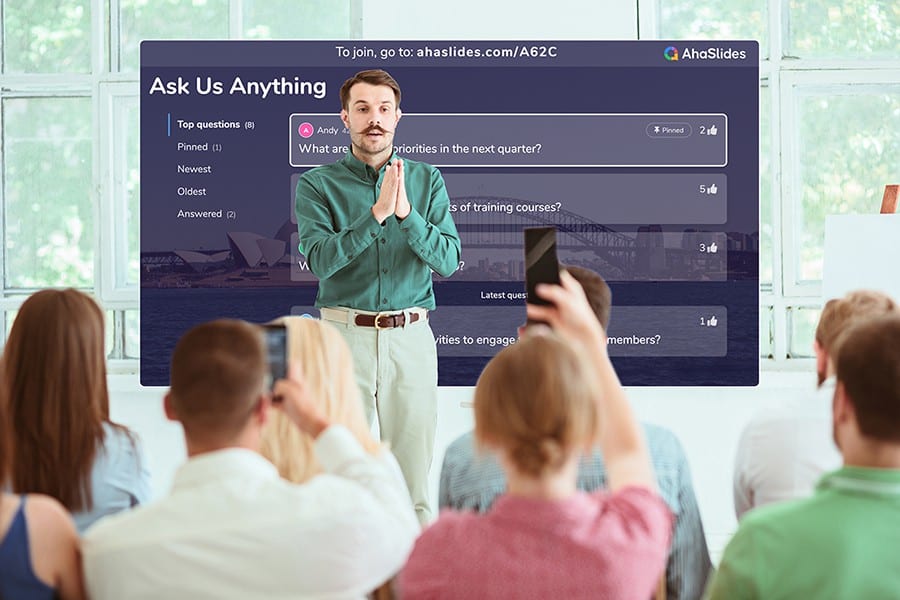
Get your Students Engaged
Start meaningful discussion, get useful feedback and educate your audience. Sign up to take free AhaSlides template
The Importance of Presentation Ending?
Why care about your presentation's conclusion? It's not just a formality; it's critical. The conclusion is where you make a lasting impression, reinforce key points for better retention, motivate action, and ensure your audience remembers your message.
Plus, a strong conclusion reflects your professionalism and shows you've thoughtfully considered how to leave a lasting impact. In essence, it's your final opportunity to effectively engage, inform, and persuade, ensuring your presentation achieves its objectives and is remembered for the right reasons.
How to End A Presentation Successfully: A Complete Guide with Examples
Effectively ending a presentation is essential to leave a lasting impression on your audience and drive your message home. Here's a step-by-step guide on how to effectively end a presentation
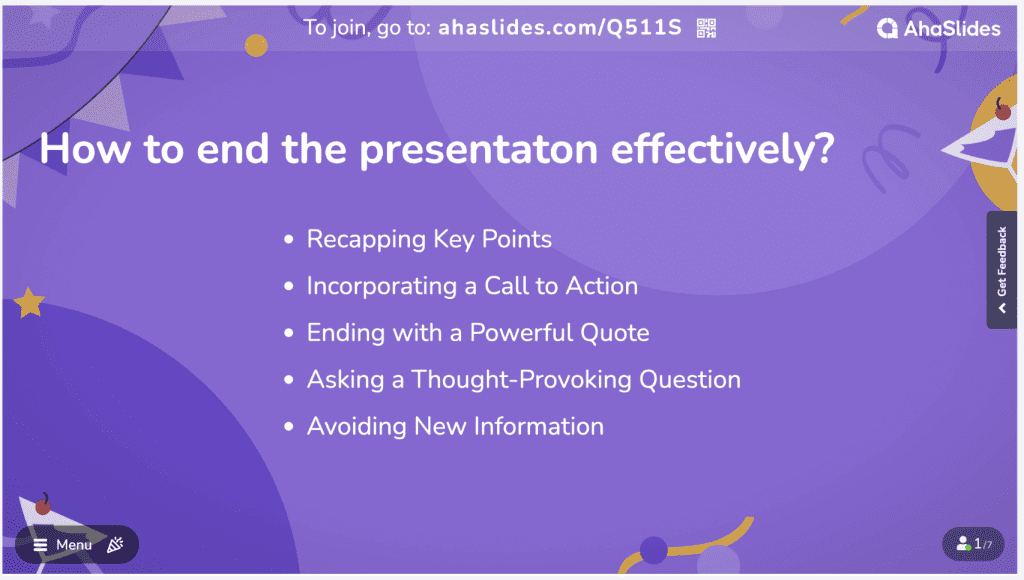
One of the primary functions of a conclusion is to summarize the main points you've covered in your presentation. This recap serves as a memory aid, reinforcing the key takeaways for your audience. It's essential to do this succinctly and clearly, ensuring that the audience can easily recall the core ideas. For example:
- "We've delved into the factors that drive motivation - setting meaningful goals, overcoming obstacles, and fostering a positive mindset. These are the building blocks of a motivated life."
- "Before we conclude, let's come back to our core theme today - the incredible power of motivation. Our journey through the elements of inspiration and self-drive has been both enlightening and empowering."
* This step also is a great place for leaving a vision . A phrase that is commonly used is: "Visualize a world where people are empowered, pursuing their passions, and breaking barriers. It's a world where motivation fuels progress and dreams become reality. This vision is within reach for all of us."
How to write the end of the presentation? A powerful conclusion that motivates your audience to take action can be an excellent idea. Depending on the nature of your presentation, this could involve encouraging them to make a purchase, support a cause, or implement the ideas you've presented. Be specific in your call to action, and make it compelling and achievable. An example of a CTA ending can be:
- "Now, it's time for action. I encourage each of you to identify your goals, create a plan, and take the first step toward realizing your dreams. Remember, motivation without action is just a daydream."
How to end a presentation impressively? "As the great Maya Angelou once said, 'You may not control all the events that happen to you, but you can decide not to be reduced by them.' Let's remember that we have the power to rise above challenges." Conclude with a relevant and impactful quote that relates to your topic. A well-chosen quote can leave a lasting impression and inspire reflection. For example, Julius Caesar utilized this technique when he said, "I came, I saw, I conquered." Some best phrases to use on your ending are:
- Feel free to reach out if you have any questions.”
- “For more information, head to the link on the screen.”
- “Thank you for your time/attention.”
- “I hope you found this presentation informative/useful/insightful.”
How to end a presentation without using the Thankyou slide? Pose a question that encourages your audience to think or reflect on the material you've presented. This can engage the audience and stimulate discussion.
For instance: You can start a statement like: "I'm here to address any questions or listen to your thoughts. Do you have any questions, stories, or ideas you'd like to share? Your voice is important, and your experiences can inspire us all."
💡Using live Q&A features from interactive presentation tools like AhaSlides to increase your audience engagement. This tool is integrated into PowerPoint and Google Slides so you can show it to your audience instantly and update the response in real-time.
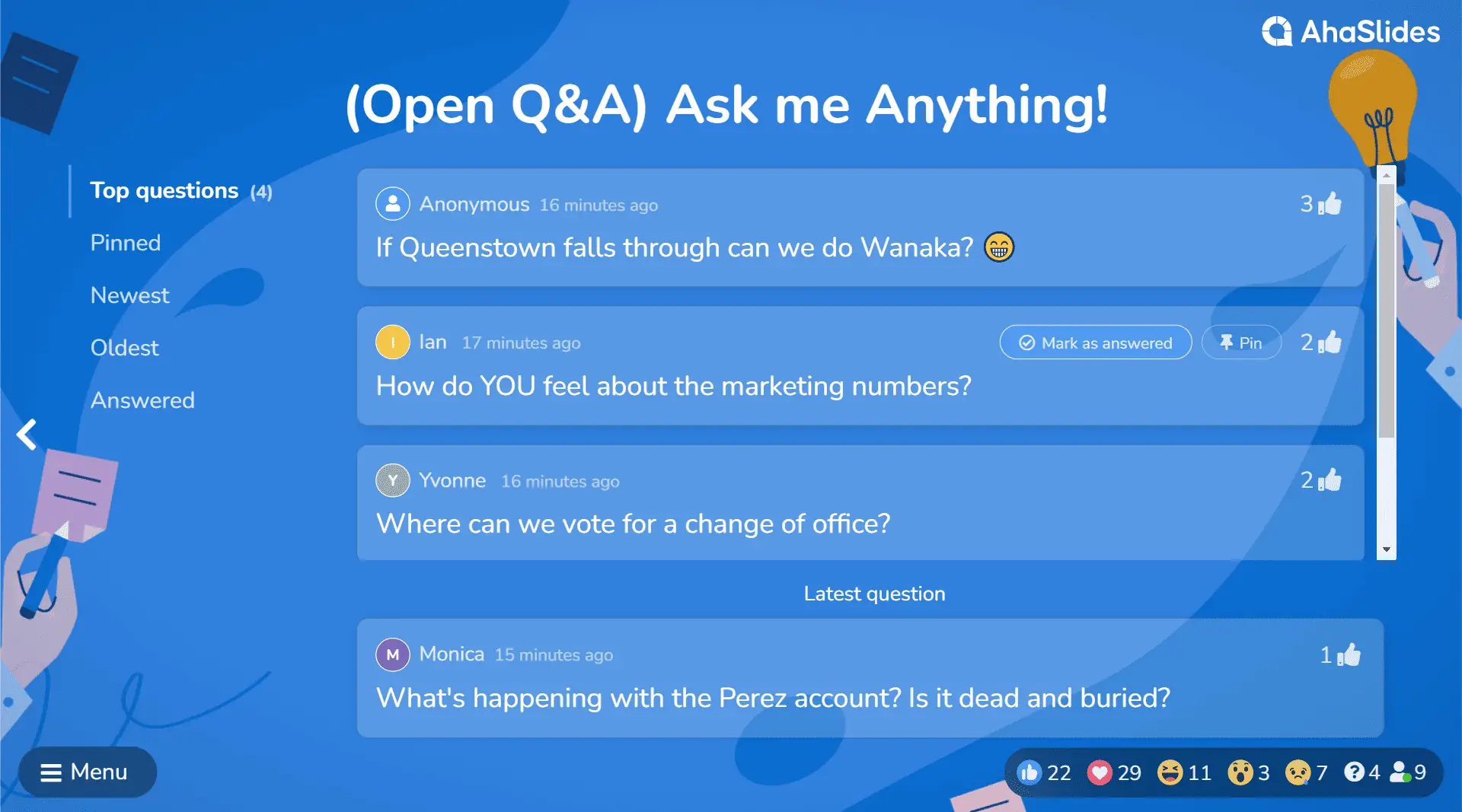
The conclusion is not the place to introduce new information or ideas. Doing so can confuse your audience and dilute the impact of your core message. Stick to what you've already covered and use the conclusion to reinforce and emphasize the existing content.
💡Check out Thank You Slide For PPT | Create a Beautifully One in 2024 to learn about creating innovative and appealing Thank-You Slides to end any type of presentation, whether it is for academic or business purposes.
In summary, an effective conclusion serves as a concise recap of your presentation, encourages your audience to take action, and refrains from introducing new information. By accomplishing these three objectives, you'll create a conclusion that reinforces your message and inspires your audience to respond positively.
The timing for concluding a presentation depends on various factors, including the nature of your content, your audience, and any time constraints. Here are some general guidelines to help you determine when to conclude your presentation:
- Avoid Rushing : Avoid rushing through your conclusion due to time constraints. Ensure that you have allocated sufficient time for the conclusion so that it doesn't feel abrupt or hurried.
- Check Time Limits : If you have a specific time limit for your presentation, keep a close eye on the time as you approach the conclusion. Be prepared to adjust the pace of your presentation to ensure you have ample time for the conclusion.
- Consider Audience Expectations : Consider the expectations of your audience. If they anticipate a specific duration for your presentation, try to align your conclusion with their expectations.
- Wrap Up Naturally : Aim to conclude your presentation in a way that feels natural and not abrupt. Provide a clear signal that you're moving into the conclusion to prepare your audience for the end.
How to end a presentation? The key is to balance the need to convey your message effectively with the available time. Effective time management and a well-planned conclusion will help you wrap up your presentation smoothly and leave a positive impression on your audience.
🎊 Learn: Best Q&A Apps to Engage With Your Audience | 5+ Platforms For Free in 2024
How to end a presentation impressively in your opinion? As mentioned, there are many ways to engage your audience until the last minute, from a strong CTA, a captivating ending slide, thoughtful Q&A session. Don't force yourself to make an ending that you might not be comfortable with, act as naturally as possible.
💡Want more inspiration? Check out AhaSlides right away to explore more innovative methods to enhance audience engagement and collaboration!
What do you say at the end of a presentation?
At the end of a presentation, you typically say a few key things:
- Summarize your main points or key takeaways to reinforce the message.
- Provide a clear call to action, motivating your audience to take specific steps.
- Express gratitude and thank your audience for their time and attention.
- Optionally, open the floor for questions or comments, inviting audience engagement.
How do you end a fun presentation?
To conclude a fun presentation, you can share a light-hearted, relevant joke or humorous anecdote, encourage the audience to share their own fun or memorable experiences related to the topic, end with a playful or uplifting quote, and express your excitement and appreciation for the enjoyable presentation experience.
Should you say thank you at the end of a presentation?
Yes, saying thank you at the end of a presentation is a courteous and appreciative gesture. It acknowledges your audience's time and attention and adds a personal touch to your conclusion. It can be especially important in thank-you presentations and is generally a polite way to wrap up any type of presentation.
Ref: Pumple

Astrid Tran
I've got my rhythm with words
Tips to Engage with Polls & Trivia
More from AhaSlides
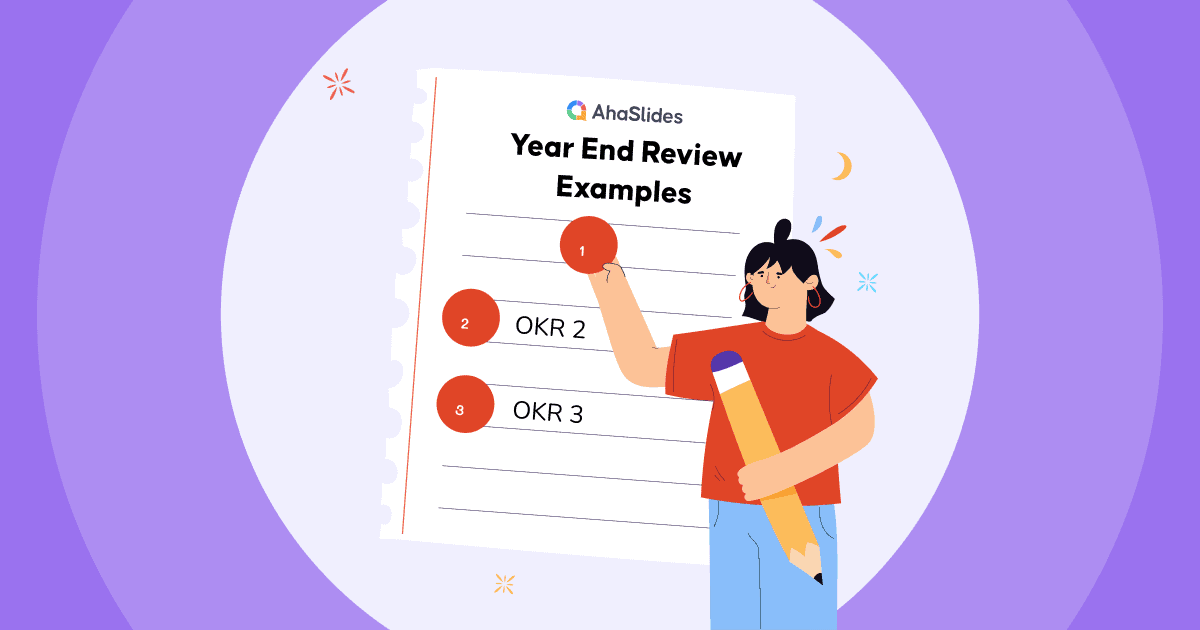

IMAGES
COMMENTS
At the end of your presentation, you have the power to leave a lasting impact on your audience. A persuasive ending can drive home your key message and encourage action. Sales and Persuasion Tactics. When you’re concluding a presentation with the goal of selling a product or idea, employ carefully chosen sales and persuasion tactics.
Jan 23, 2023 · Here are 10 powerful examples of how to end a presentation that does not end with a thank you slide. How many presentations have you seen that end with “Thank you for listening” or “Any questions?” I bet it’s a lot… “Thank you for listening.” is the most common example.
May 9, 2023 · This simple act of gratitude can also create a sense of personal connection and signal to your audience that the presentation has reached its conclusion, paving the way for future interactions with them. 6. End with a powerful quote: One effective strategy to end your presentation on a high note is by leaving the audience with a powerful quote.
Examples of how to end a presentation with conclusion slides: Here are some examples of effective presentation conclusion slides that you can refer to for inspiration in crafting your next presentation's ending. Feel free to use them directly or adapt them to suit your specific needs and style.
Jan 31, 2024 · This underlines why the end of your presentation is so important. If you design the end of your presentation effectively, your audience is more likely to remember it. Use this psychological phenomenon to your advantage and ensure that your conclusions and calls to action are remembered. Presentation end: 7 examples to leave a lasting impression
Apr 8, 2024 · In summary, an effective conclusion serves as a concise recap of your presentation, encourages your audience to take action, and refrains from introducing new information. By accomplishing these three objectives, you'll create a conclusion that reinforces your message and inspires your audience to respond positively.